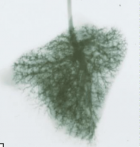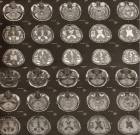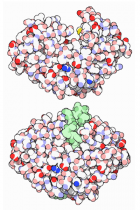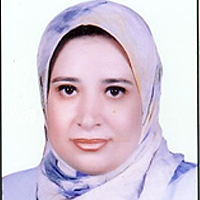Table of Contents
A pregnant with markedly elevated alkaline phosphatase: a case report
Published on: 21st March, 2023
Alkaline Phosphatase (ALP) is produced from the liver, kidney, bone and placenta. During pregnancy, ALP may raise markedly with no clear reason. Here, we present a rare case of highly elevated ALP in a 21 years old pregnant woman during the third trimester who had no important past medical history. It was 2800 U/L. Bone, renal, or liver was all normal. Close monitoring of the fetus and his mother until birth was the way of treatment. We had seven weeks postpartum to decline in ALP concentration but did not return to the normal range. The placenta showed lesions of chronic villitis. The extreme incline in ALP during the gestational stages is riskier because the threat here is posed to 2 lives. In such conditions, constant monitoring of ALP in the maternal serum backed with necessary medication is required.
SARS-CoV-2 infection does not affect ovarian reserve in women undergoing assisted reproduction
Published on: 7th March, 2023
Information regarding the effects of the novel coronavirus on human reproduction is currently limited. The objective of our work was to assess whether, in women who have passed the disease, there was a variation in the ovarian reserve through the determination of AMH levels. During May-June 2020, women performing an Assisted Reproductive treatment and who had a positive IgG for SARS-CoV-2 were included in the study; this group of women had a previous AMH determination of no more than 6 months. Women were stratified into two groups, according to their previous AMH levels: low responders (AMH<1 ng/ml) or normal-high responders (AMH ≥ 1 ng/ml) Statistical analyses were performed using the Statistical Package for Social Sciences 19.0 (IBM Corporation, Armonk, NY, USA). A total of 46 patients were included in the study; 16 women were diagnosed as having low ovarian reserve (AMH < 1 ng/ml), with an average age of 38.6 years, whereas 30 were classified as having normal ovarian reserve (AMH ≥ 1 ng/ml), with an average age of 34.7 years. Generally, the data show no variation in AMH levels before and after SARS-CoV-2 infection (1.73 ng/ml vs. 1.61 ng/ml, respectively). However, when we analyzed these differences according to the study groups, the results were consistent with the patient's ovarian status. It is possible to conclude that the fact of having passed the disease does not affect the ovarian reserve status but the degree of the variation of AMH levels depending on the patient was a low or high responder.
Decline in human sperm parameters: How to stop?
Published on: 31st January, 2023
A large systematic review and meta-regression analysis found that sperm counts all over the world appeared to be declining rather than stabilizing. The decline in male sperm counts does not necessarily translate to a decline in male fertility. The cause of declining sperm counts remains unknown; however, several potential causative factors have been identified: 1. Chronic diseases: diabetes mellitus, hypertension; hyperlipidemia, hyperuricemia and skin Diseases & metabolic syndrome. 2. Environmental factors: bisphenol a; phthalates; heavy metals and heat. 3. Lifestyle: obesity, diet, tobacco, alcohol, marijuana, stress, reduced sleep & sedentary life. Addressing these causes is required to stop or decrease male fertility decline. Action to improve semen quality such as prevention & treatment of chronic disease, decreasing unhealthy lifestyle behaviors such as smoking, poor diet, or lack of physical activity & eliminating toxic environmental chemicals.
Rhabdomyolysis in a pregnant woman: A case report
Published on: 16th January, 2023
Hyperemesis gravidarum may prompt hypovolemia and significant electrolyte anomalies. Hypokalemia is one of the most common abnormalities. When practical, it may lead to rhabdomyolysis. We report a rare case of rhabdomyolysis in a 24 years old pregnant woman due to hyperemesis gravidarum. She had a profound weakness. Physical examination and laboratory findings showed a need for the hospital admission. Aggressive rehydration and electrolytes were the definite treatment. Her serum creatinine kinase (CK) concentration during entry was 80,01 units/L.Continuous rehydration led to complete recovery clinically. On discharge, she had normal laboratories.
Meigs syndrome: About an uncommon case report
Published on: 6th January, 2023
Background: Ovarian fibroma is a very unusual epithelial tumor representing less than 1% of all ovarian tumors. It can be asymptomatic and discovered during surgery or be associated with a pleural effusion preferentially located on the right side and a more or less abundant free ascites in the framework of the so-called Meigs syndrome. The challenge of management then lies in distinguishing benign from malignant since clinically, radiologically, and biologically everything points towards malignant which requires radical surgical treatment. We report here the case of a 69-year-old postmenopausal patient with a clinical form of Meigs' syndrome that strongly suggested ovarian cancer.Case presentation: We hereby report here the case of a 69-year-old patient, menopausal, gravida 4 para 3 with 3 live children delivered vaginally and one miscarriage. She presented with ascites, hydrothorax, and a solid tumor of the ovary. Serum CA 125 and HE 4 levels were very high. ROMA score was highly suggestive of malignancy. A hysterectomy with adnexectomy was performed. It was only the histological evidence of ovarian fibroma and the rapid resolution of its effusions that confirmed Meigs syndrome.Conclusion: Meigs syndrome is an anatomical-clinical entity that associates a benign tumor of the ovary, ascites, and hydrothorax. Highly elevated CA 125 and HE-4 tumor markers often point clinicians toward a malignant tumor and compel radical surgical treatment. This case report reminds us once again that only histology confirms the diagnosis of cancer.
Cesarean scar pregnancy: A clinical case report
Published on: 6th January, 2023
Background: Among the different forms of ectopic pregnancy, cesarean scar pregnancy is one of the most uncommon with an estimated incidence of 1/1800 pregnancies. A major risk of massive hemorrhage, it requires active management as soon as it is diagnosed because it can affect the functional prognosis of the patient (hysterectomy) but can also be life-threatening. Different surgical techniques are generally proposed in first intention to patients who no longer wish to have children, who are hemodynamically unstable and/or in case of failure of medical treatment.Case presentation: We hereby report the case of a young 19-year-old patient with no particular medical history, gravida 2 para 1 with a live child born after a cesarean section for fetal heart rhythm abnormalities during labor 5 months earlier and who presented to the emergency room of our structure for the management of a cesarean pregnancy scar diagnosed at 6 weeks of amenorrhea. She was successfully managed with an intramuscular injection of methotrexate. The follow-up was uneventful.Conclusion: The implantation of a pregnancy on a cesarean section scar is becoming more and more frequent. With consequences that can be dramatic, ranging from hysterectomy to life-threatening hemorrhage, clinicians must be familiar with this pathological entity and be prepared for its management. The latter must be rapid and allow, if necessary, the preservation of the patient's fertility. In this sense, conservative medical treatment with methotrexate injections should be proposed as a first-line treatment in the absence of contraindication.
Prevalence and risk factors of lower urinary tract symptoms after robotic sacrocolpopexy
Published on: 5th January, 2023
Aims: To analyze the prevalence and risk factors for postoperative lower urinary tract symptoms (LUTS) in women submitted to robot-assisted sacrocolpopexy (RASC) for correction of pelvic organ prolapse (POP).Methods: A longitudinal prospective study was carried out on 51 consecutive women who underwent RASC to treat POP. We recorded preoperatively the presence of LUTS urgency, symptomatic stress urinary incontinence (SUI), and voiding difficulty. We also performed an urodynamic study prior to surgical intervention including an incontinence test for overt and occult stress urinary incontinence (with POP reduction). A transobturator suburethral sling (TOT) was implanted in patients with demonstrable urodynamic SUI (overt or occult). Patients' LUTS were reassessed at 6 months after the surgical intervention. McNemar test and the Fisher exact test were used to analyzing dependent variables and Student’s t - test for independent variables. Statistical significance was set at p ≤ 0.05.Results: Postoperative voiding difficulty and symptomatic SUI were significantly reduced. No significant differences were observed in the postoperative prevalence of urgency. The presence of preoperative urinary urgency was the only significant risk factor of postoperative urgency, whereas TOT placement was the only significative factor associated with postoperative symptomatic SUI. TOT placement in patients with occult SUI significantly reduced postoperative Symptomatic SUI.Conclusion: RASC reduces the prevalence of voiding difficulty but not urgency. Concomitant implantation of TOT in patients with preoperative urodynamic SUI (overt or occult) is useful to reduce symptomatic postoperative SUI.

If you are already a member of our network and need to keep track of any developments regarding a question you have already submitted, click "take me to my Query."



















































































































































